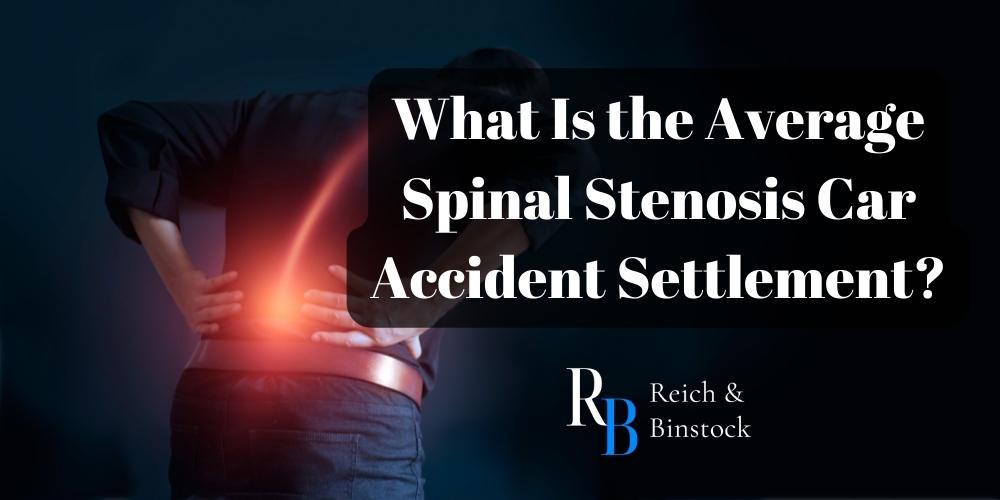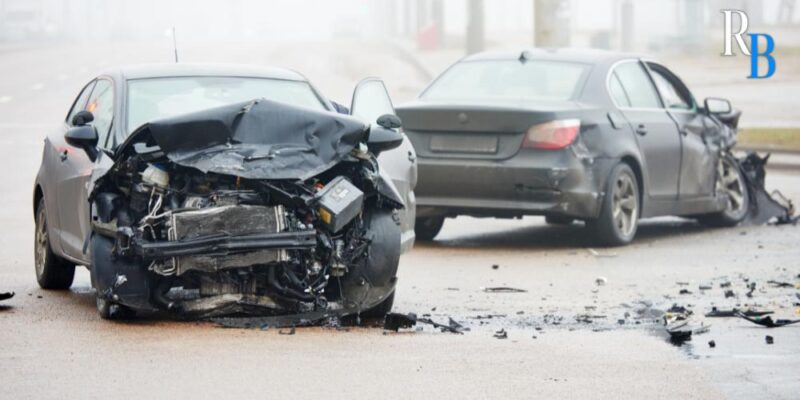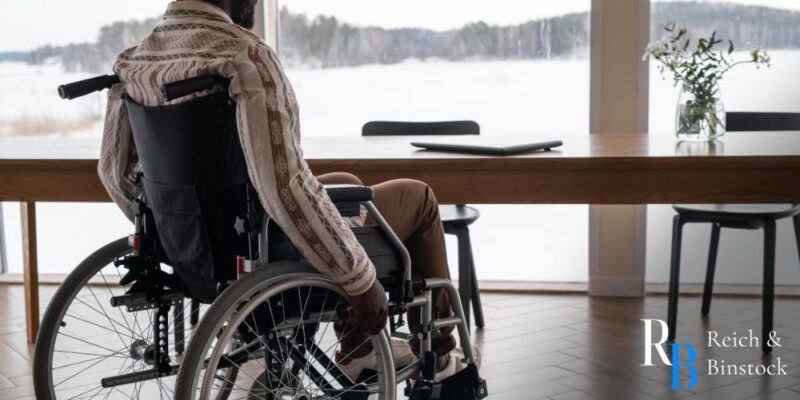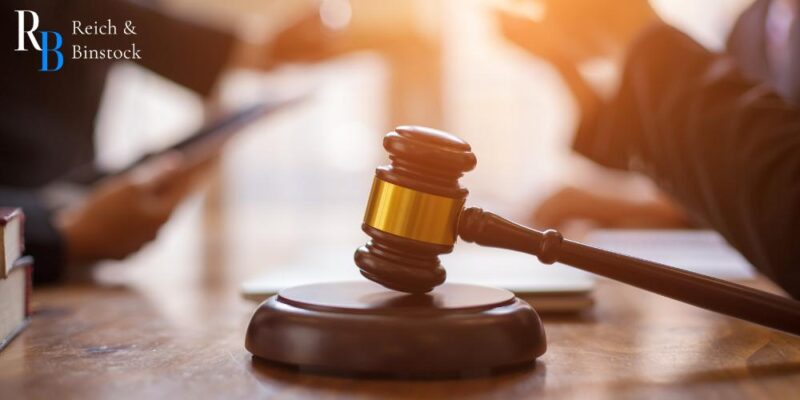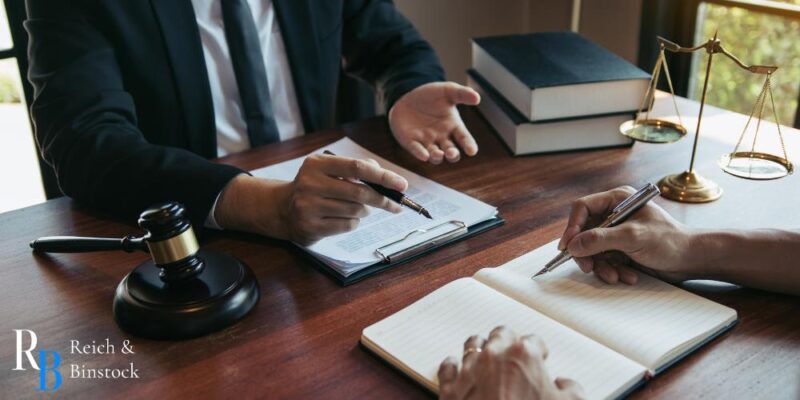As we all know, there are a plethora of injuries that may result from an automobile accident. There is also the risk that some of these injuries may lead to the development of further injuries. The significant strain placed on a person’s body in the event of a car accident can lead to serious injury. Spinal stenosis is one of these injuries. To better understand the value of your spinal stenosis car accident settlement, we strongly recommend speaking with an attorney.
It is important that those who develop such an injury after an accident seek a spinal stenosis car accident settlement with the help of an attorney. The experienced Houston car accident lawyers at Reich & Binstock can help. In this post, we’ll answer your questions regarding a spinal stenosis injury and what a settlement for that might look like. To schedule a free consultation about your case, please call our office at 713-622-7271 today.
What Is Spinal Stenosis?
Spinal stenosis is a condition in which the bony spaces within your spine narrow, putting pressure on nerves that travel through it. It most often occurs in the lower back and neck regions of the human body. Individuals with spinal stenosis may not have symptoms right away, but they could experience pain or tingling sensations over time as their condition worsens.
Spinal stenosis commonly results from wear and tear of the aging body, typically related to osteoarthritis. Osteoarthritis occurs when the smooth cartilage that connects the backs of vertebrae together begins to break down. When this happens, your bones may rub against one another, leading to abnormal bone growth. This can directly contribute to the narrowing of those bony openings, also known as foramina. Other factors, such as degenerative disc disease, spinal deformities, or cyst growths, can contribute to spinal stenosis, as well.
Is Spinal Stenosis a Permanent Injury?
In many cases, spinal stenosis can be a serious medical condition, and its impact on an individual can vary. After developing spinal stenosis, some individuals may experience long-term or even permanent effects, while others may find relief through various treatments.
Spinal cord injuries and conditions affecting the spinal canal can be extremely painful, so it makes sense that injury victims would want to know if that pain will be permanent. Severe instances of spinal stenosis may result in persistent pain, mobility limitations, and neurological issues that could endure over time. The progression and permanence of the injury depend on factors such as the underlying cause of the stenosis, the effectiveness of treatment, and individual health considerations.
What Aggravates Spinal Stenosis?
Various factors can aggravate spinal stenosis, and understanding these triggers is crucial for individuals managing this condition. Specific aggravating factors include age-related degeneration, osteoarthritis, herniated discs, and ligament thickening.
In the context of a car accident, the impact forces involved can potentially exacerbate spinal stenosis. The abrupt and forceful movements during a collision may cause trauma to the spine, leading to increased compression of the spinal cord or nerves. Whiplash, a common injury in car accidents, involves a sudden backward and forward motion of the head and neck, which can contribute to the worsening of spinal stenosis symptoms.
A skilled personal injury attorney can help you gather evidence to show that the car accident has contributed to either the development or worsening of your spinal stenosis.
Can a Car Accident Cause Spinal Stenosis?
While a car accident cannot actually cause spinal stenosis, it can cause an injury that leads to spinal stenosis. It can also cause an asymptomatic case of spinal stenosis to become aggravated and present symptoms. A person with spinal stenosis might not always be aware that they have it because they may not feel any symptoms. However, it is highly possible that a person may experience a traumatic accident that leads to the onset of these symptoms.
Being involved in a car accident may cause internal structural injuries, including injury to the spine. It is very common for a person involved in a collision to obtain back and neck injuries. This injury might immediately lead to the development of spinal stenosis, or it may cause it to develop slowly over time due to spinal degeneration.
What Is Foraminal Stenosis Caused by Trauma?
Foraminal stenosis, one of the specific types of spinal stenosis, is often a result of the aging process. However, it is possible for trauma to cause foraminal stenosis. For example, if someone were involved in an accident that resulted in a bulging or herniated disc.
This injury could cause the discs between your spinal bones to become damaged or slip out of place and lead to foraminal stenosis. Bone spurs resulting from trauma or injury often pinch the nerves running through the spine and may also cause stenosis.
What Aggravates Foraminal Stenosis?
Several factors can aggravate foraminal stenosis, intensifying symptoms and affecting an individual’s overall well-being. One primary contributor is the natural aging process, which can lead to degenerative changes in the spine, including the thickening of ligaments and the development of bone spurs, both of which can contribute to the compression of spinal nerves.
Personal injury cases like car accidents, especially those involving sudden impact or whiplash, can potentially aggravate foraminal stenosis. The forceful movements experienced during a collision can lead to trauma in the spine, affecting the foramen and increasing pressure on spinal nerves. Whiplash, in particular, involves rapid back-and-forth movement of the neck, which can contribute to the compression of nerves exiting the foramen.
Can a Person Be Paralyzed by Spinal Stenosis?
If the spinal stenosis is severe enough, there is a chance that it could lead to paralysis. This is the case when lumbar spinal stenosis causes the rare but serious condition of cauda equina syndrome. The cauda equina is a collection of nerves at the bottom of the spinal cord. These nerve roots provide sensory and motor functions to the lower half of the body, including the legs, bladder, and genital areas.
Cauda equina syndrome, or CES, occurs when nerve roots become compressed. This compression obstructs the motor and sensory functions of the lower extremities. It may result in symptoms such as bowel or bladder incontinence or loss of sensation in the genital region. Pain, numbness, weakness, and heaviness in the legs are also common symptoms. CES is a medical emergency, as it has the potential to lead to permanent paralysis if not properly treated.
Though it primarily occurs in adults, anyone who experiences spinal trauma or injury may develop cauda equina syndrome. CES can affect any age, gender, or race. The most common cause is due to a herniated disc located in the lumbar region, which in turn may lead to spinal stenosis and, thus, CES. A herniated disc is often the result of a strain or impact injury.
Other potential causes of CES include:
- Spinal lesions or tumors
- Arteriovenous malformations (AVMs)
- Birth abnormalities
- Spinal hemorrhages
- Infections or inflammation of the spine
- Postoperative spine surgery complications
- Spinal anesthesia
- Traumatic injuries to the back, including Houston car accidents, slip and fall injuries, gunshot wounds, etc.
What Are the Long-Term Effects of Spinal Stenosis?
Suffering a back injury can not only be extremely painful, but it also can follow you around for the rest of your life. As spinal stenosis may result from a variety of factors, it can also lead to a variety of possible medical conditions. Though it’s rare, cases of untreated spinal stenosis can lead to long-term effects of weakness, numbness, incontinence, and balance problems. As we mentioned above, there are even cases where spinal stenosis may lead to permanent paralysis.
The long-term effects caused by spinal stenosis have the potential to be life-altering. It’s extremely important that anyone who suffers from this condition due to another’s negligence seeks a spinal stenosis car accident settlement. Achieving a settlement for your injuries can help pay for any necessary medical treatment and ensure that you have the best chance at recovery, avoiding any negative long-term effects.
Can I Sue for Spinal Stenosis?
An individual who develops a case of spinal stenosis due to someone else’s actions may have the ability to sue the responsible person. The negligence of one person, including both accidental and intentional actions, that results in another’s injuries is certainly grounds for a legal case.
To receive a spinal stenosis car accident settlement, one must file a personal injury lawsuit against the liable party.
For the lawsuit to be successful, the plaintiff must prove the following:
- The defendant owed a duty of care to the plaintiff.
- The defendant breached or failed to uphold that duty of care.
- Negligent conduct of the defendant was the direct cause of the injuries. In this case—spinal stenosis.
- The plaintiff must calculate the amount of damages and losses caused by the injury they sustained.
In the case of a car accident, the responsible driver owed the plaintiff and all other drivers on the road a duty of care. Anyone who gets behind a wheel is responsible for more lives than just their own, after all. They’re expected to obey all laws and road regulations, drive with the utmost caution at all times, and avoid any negligent driving actions. Breaching that duty might look like anything from texting while driving to excessively speeding to driving while intoxicated.
If you can prove that the defendant’s actions were a direct cause of your injuries, you may recover various damages. These damages include pain and suffering, medical bills, lost wages, and more.
What Is the Average Settlement for Spinal Stenosis?
It is difficult to estimate the average value ranges for spinal stenosis settlements. No personal injury attorney can give a clear average without first evaluating your case. Even if we look at existing settlements for these claims, this information is insufficient to give average settlement estimates. Settlement values also depend on how cooperative an insurance company is during a case.
Ultimately, the best way to understand the value of your claim is to speak with qualified personal injury lawyers. They will evaluate your damages and give you a better idea of what your claim is worth.
Cervical Spinal Stenosis Settlement
Determining the average settlement for cervical stenosis can be challenging, as settlement amounts vary widely based on several factors. The value of a settlement depends on the specific circumstances of the case, including the severity of the injury, the impact on the individual’s life, medical expenses, lost wages, and other damages.
Cases involving cervical spine conditions may result in higher settlements if the condition leads to significant impairment, ongoing medical treatment, or a substantial impact on the individual’s ability to work and enjoy life. Additionally, the degree to which another party’s negligence is established as the cause of the spinal stenosis or its exacerbation can influence the settlement amount.
Lumbar Stenosis Settlement
Knowing the average settlement for lumbar stenosis can be complex, as settlement amounts vary widely based on numerous factors. The value of a settlement is influenced by the specific details of the case, including the severity of the lumbar stenosis, its impact on daily life, medical bills, lost wages, and more.
Cases involving lumbar spine conditions may result in higher settlement values if the victim experiences serious impairment. Other factors that can increase the value include ongoing medical treatments, effects on daily life, and others.
Foraminal Stenosis Settlement
As with other spinal injury cases, foraminal stenosis settlements increase in value as the severity of the condition increases. The more impairment, pain, and medical treatments a victim must endure, the more likely they are to get a higher settlement.
Severe Bilateral Neural Foraminal Stenosis Settlement
In serious cases, such as severe bilateral neural foraminal stenosis, the potential settlement values could be much higher. This is due to the significant impact on the victim’s daily life and ability to work, as well as the necessary medical treatments.
What Factors Can Impact Your Settlement’s Value?
The settlement value after a car accident is influenced by various factors that collectively determine the compensation an individual may receive. An experienced car accident attorney can help you properly value your claim by examining these factors. Some key factors that can impact the settlement value include the following.
Cost of Medical Expenses and Physical Therapy
The total medical expenses incurred from treating spinal stenosis, including hospital bills, surgeries, rehabilitation, and ongoing treatment, contribute to the overall settlement amount.
The presence of pre-existing medical conditions may impact the evaluation of injuries and the settlement amount. It’s essential to establish the connection between the accident and any exacerbation of existing conditions.
Impact of the Condition on Your Daily Life
The extent and severity of injuries sustained in the car accident play a significant role. More severe injuries to the spinal column that result in long-term effects or disability often lead to higher settlements.
Mobility and Pain Levels
Non-economic damages, including physical pain, emotional distress, and the overall impact on the quality of life, are factored into the settlement amount. Spinal stenosis symptoms often include pain, numbness, loss of sensation, loss of mobility, and weakness. All of these symptoms are factored into the final settlement amount.
Other Factors
Compensation for lost wages due to time away from work caused by injuries sustained in the accident is a crucial factor. This includes both current and future lost income.
The cost of repairing or replacing damaged property, such as the vehicle involved in the accident, is considered in the settlement calculation.
The determination of fault in the car accident injury and the degree of negligence by each party involved can affect the settlement. If one party is clearly at fault, their liability may result in a higher settlement.
The insurance policies of the parties involved, including their coverage limits, can impact the available funds for settlement. If the at-fault party has limited insurance coverage, it may affect the overall settlement amount.
Quality legal representation can influence negotiations and the ability to secure a favorable settlement. Experienced Houston personal injury attorneys can advocate effectively for their clients.
What Are the Benefits of Hiring an Attorney for Your Spinal Stenosis Case?
Hiring a skilled personal injury lawyer for your spinal stenosis case can provide several benefits. Attorneys experienced in personal injury law, such as those at Reich & Binstock, possess the expertise to navigate the complexities of legal proceedings related to spinal stenosis claims.
They can assess the specific details of your case, gather necessary evidence, and advocate on your behalf. An attorney can help determine liability, negotiate with insurance companies, and pursue fair compensation for medical expenses, pain and suffering, and other damages.
Our legal knowledge ensures that you are aware of your rights and that your case is presented effectively, increasing the likelihood of a favorable outcome in your spinal stenosis claim.
You May Be Entitled to a Spinal Stenosis Car Accident Settlement
At Reich & Binstock, our Houston spinal cord injury attorneys have filed lawsuits for clients all over Texas who’ve suffered injuries at the hands of another. We are well aware of the duty of care that drivers must meet, and we know how to hold them accountable if they don’t. If you’ve suffered as a result of another driver’s negligence, contact the dedicated attorneys at Reich & Binstock today.
Not sure whether you might have a compensable injury? We are available to give you our honest opinion and advise you on what to do next. Call 713-622-7271 or complete the online form below to schedule a free consultation.

